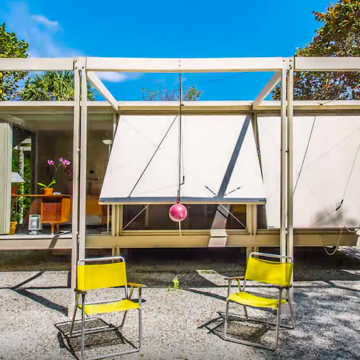The attention lavished on the Walker Guest House soon after its completion in 1952 reflects the strengthening of connections between midcentury modernism in Florida and the rest of the United States. Already in 1957, readers of Architectural Record named this small, 576-square-foot winter house, located on Sanibel Island on the Gulf Coast, one of the most important twentieth-century houses, joining the ranks of Mies van der Rohe’s Farnsworth House and Philip Johnson’s Glass House, both of which were finished only the year before. Even today, Rudolph’s house stands outs among those buildings in this survey as the only structure to have been reconstructed in replica while it still exists in situ. The house was commissioned by the Minneapolis physician Walter Walker, whose family started what is now the Walker Art Center in that city.
Set close to the road, well away from the dunes and water’s edge, the small winter retreat consists of three concentric grids. The outermost five-by-five grid of open lumber frame acts as a machine for controlling the relationship between the interior and exterior, an important feature for an oceanfront location. The frame provides the structure for top-hinged flaps or shutters, two on each side, that open and close with the help of heavy red balls as counterweights. The shutters do not entirely close the house, but when closed help the inhabitants feel that they are in a “snug cottage,” as architect Paul Rudolph put it. And when the flaps are open, Rudolph noted, the space becomes something of a pavilion.
As the architecture critic Alastair Gordon has observed, the guest house is clearly a product of its time. Its compact spaces and hardware grew out of the architect’s experiences in the Navy during World War II. Its responsiveness to modernism is clear in its transparency, the use of everyday materials for construction, and in the lightness of touch as it rests on the ground. It looks back to the light structures created by Native Americans and forward to the mechanical wonder of the lunar module that would touch down on the moon. Likewise, the carefully planned layout of the innermost blocks of the grid neatly project spaces to live, eat, cook, and sleep, with each looking out into the landscape. At the same time, this inner world holds the potential for the entire structure to “duck and cover” in the event of an emergency. As a document of its time, the building is fascinating. Likewise, as a document for our times, the building has much to say about economies of scale, sustainability, and resilience.
In 2015, the Sarasota Architecture Foundation created a full-scale, furnished replica of the Walker Guest House. It was on display at the Ringling Museum in Sarasota until 2017, and is on loan to the Palm Springs Modern Committee in California until 2020. The Walker family still uses the original structure as a guest house.
References
Domin, Christopher, and Joseph King. Paul Rudolph: The Florida Houses.New York: Princeton Architectural Press, 2002.
Gordon, Alastair. “Tiny House on Sanibel Island Stands as a Simple Symbol of Hope.” Visual Arts Section. The Miami Herald, April 10, 2015.
Howey, John. The Sarasota School of Architecture.Cambridge: MIT Press, 1995.
Rohan, Timothy M. The Architecture of Paul Rudolph.New Haven: Yale University Press, 2014.
Rudolph, Paul. “Regionalism in America.” Perspecta4 (1957): 12-19.
Shear, John Knox. “Walker Guest House, Sanibel Island, Florida, 1953, Paul Rudolph.” Architectural Record121 (February 1957): 204.

